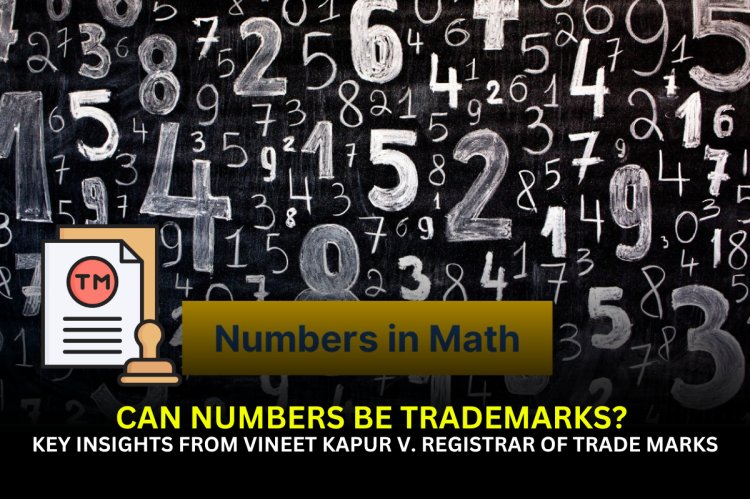Can Numbers Be Trademarks? Key Insights from Vineet Kapur v. Registrar of Trade Marks
Explore the Delhi High Court's ruling in Vineet Kapur v. Registrar of Trade Marks, which clarifies when numerals can qualify as trademarks under Indian law. Understand the role of arbitrariness, distinctiveness, and legal provisions in numeric trademark registration.

Introduction
The use of numerals to create a specified identity in the public's mind is a creative way to seek consumers' attention. The Trade mark laws in India permit the use and registration of numerals for a unique identity. However, one should remember that not all numeric marks can be registered as a trademark. They must be considered distinctive and arbitrary by the discretion of the Registry and cover the qualifications for registration.
Legal Provisions in India
Section 2(1)(m) of the Trade Marks Act, 1999, defines the word “mark” as including a device, brand, heading, label, ticket, name, signature, word, letter, numeral, shape of goods, packaging or combination of colours or any combination thereof. This clarifies that the use of numerals is permitted under the provisions of Trademark laws in India. However, the protection of these numerals or their combinations still depends on the degree of their arbitrariness and distinctiveness. The more distinctive and arbitrary the numerals are, the less chance of them getting rejected for registration. Several examples of numerals are used for a distinctive identity, such as 555 for incense sticks, 345 for Bidis, 91 for bicycles and 1001 for paints.
Summary of the Case
The case Vineet Kapur v. Registrar of Trademarks highlights the use of numerals as a trademark based on the principles of arbitrariness and distinctiveness. The applicant runs a cosmetics company named “O3+” and has applied for registration for a numeric trademark for mark “2929”. The appellant filed an application dated September 28, 2021, covering the following goods: cosmetics, nail polish, soaps, shampoos, perfumery, essential oils, hair lotions, hair care preparations, dentifrices, and non-medicated cosmetics. The Trade Marks Registry rejected the application to register mark ’2929’ stating that the mark lacked distinctiveness and comprised common numerals. Hence, the applicant cannot use it for his business.
The appellant challenged the order before the Delhi High Court under Section 91 of the Trade Marks Act, 1999 and Rule 156 of the Trade Marks Rules, 2017. He contended that the mark ‘2929’ was adopted when no such mark existed or was known in the market, in relation to the goods under the mark. Further, he mentioned that the mark was coined by himself and had no connection to the goods in relation to which it was sought to be used. He submitted these as the qualifications of the mark, proving the distinctiveness and arbitrary nature of the mark.
To know more about this you can follow the link below:
Court’s Analysis and Judgment
The Delhi High Court set aside the order, stating that the numerals and their combinations fall within the purview of Section 2(1)(m) and fulfil the registration requirements under the Trade Marks Act, 1999. Hence, it cannot be denied solely on the ground that it consists of numerals. Instead, the mark's distinctive nature has to be assessed for the class in relation to the products.
The appellant clarified this by stating that the mark is not connected with cosmetics or other products and is not a common numeric combination, which makes it inherently distinctive.
Additionally, the Court mentions the cases where protection to numeric marks was given in similar circumstances. It also referred to the international perspective for registration of numerals by McCarthy on Trademarks and Unfair Competition, where numerals are permitted for trademarks to identify source products. However, the Court restricted exclusive rights over the individual digits ‘2’ and ‘9’ and proceeded with the mark for advertisement in the Trademark Journal. The Court clarified that the order shall not affect any opposition proceedings instituted by any third parties, allowing this appeal.
Key takeaways from the judgment
The judgment marked major key points for the eligibility of trademark registration:
1. Inherently distinct nature of the mark: The judgment affirmed that a numeric mark has to be inherently distinct in relation to the goods or products, without having any secondary meaning for its relation with the goods. It should be able to distinguish goods without any specific secondary identity.
2. Distinctiveness Assessment: The court highlighted the necessity of assessing a mark's distinctiveness. A non-distinct mark for one class might be inherently distinctive for any other class.
3. Arbitrary Marks: A mark that is not connected to the goods or services and not relevant to their product market can be accepted as a unique mark for registration, and it is more likely to be accepted as inherently distinct.
4. No exclusive Rights on individual digits: The judgment explicitly restricted the exclusive right over individual digits. Registering a numeric combination does not provide exclusive rights over individual digits contained in that combination.
5. International status numeral trademark registration: The Court highlighted that McCarthy on Trademarks and Unfair Competition has long accepted the numeric trademark registration for specific identification.
6. ‘Proposed to be used’ basis: The mark was applied for ‘Proposed to be used’ basis, which means that a trademark can be considered inherently distinctive even before it has been used in the market in relation to any product.
Conclusion
The judgment of the Vineet Kapur case reflects the importance of the inherently distinctive nature of a mark for trademark registration. It raises crucial points to be considered by business owners before applying for any numeric marks, and clarifies the eligibility of numeric marks for registration with the specified nature. However, a mark can still be opposed by other parties even though it is eligible for registration.












